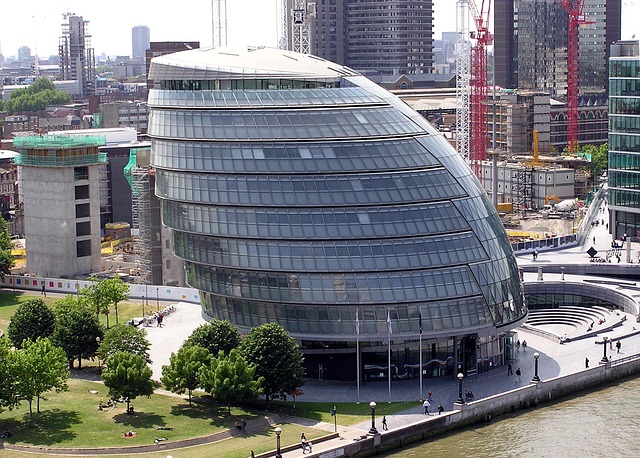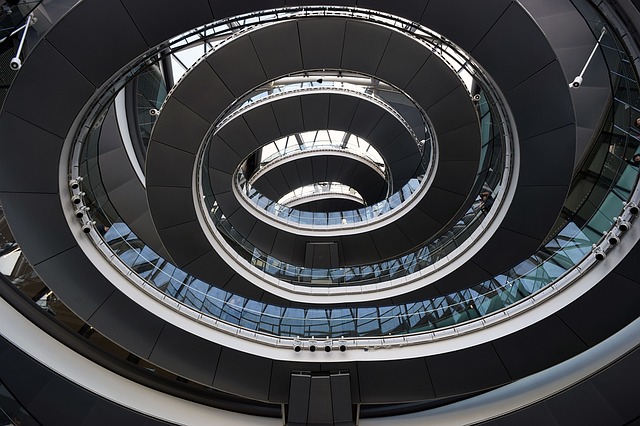City Hall, London
Contents |
[edit] Introduction
City Hall is the headquarters of the Greater London Authority (GLA) and serves as the official office for the Mayor of London and the London Assembly. Located on the south bank of the River Thames in Southwark, the building was designed by the award-winning architect Norman Foster, who drew inspiration from his earlier work on the renovation of Berlin's Reichstag. It was constructed at a cost of £43 million and opened in 2002.
The building is part of the More London development that encompasses retail, business and restaurant space on the south bank between London Bridge and Tower Bridge. Adjacent is the sunken amphitheatre The Scoop, designed to look as though the City Hall building has been scooped out of it.
It has a distinctive bulbous design derived from a modified sphere which means the building has no conventional front or rear. Each level is slightly offset from the one below, making it hang over one side of the building. As such, it has been compared to a motorbike helmet, "glass egg", a misshapen egg, and a woodlouse. Former mayor and inhabitant Ken Livingstone referred to it as “a glass testicle”, while his successor Boris Johnson opted for the nickname “The Onion”.
The top of the building houses an exhibition and meeting space called 'London's Living Room' with an open viewing deck across the Thames, said to represent the idea of transparency, which is open to the public on occasion.
[edit] Design and construction
The building was designed using advanced computer-modelling techniques that 'enabled a radical rethink of architectural form' according to architects Foster + Partners. The unusual shape was intended to achieve optimum energy performance by maximising shading and minimising the surface area that is exposed to direct sunlight.
The building's almost-spherical shape means it has around 25% less surface area than a cube building of the same volume, and so less heat escapes during winter and the building avoids overheating during summer. However, critics have pointed out that the excess energy consumption caused by the exclusive use of glass far outweighs any benefit of the shape.
The building was constructed using 2,100 tonnes of steel, 13,100 sq. m of concrete, and 7,300 sq. m of triple-glazed, low-emissivity clear glass.
Inside, a 500 m (1,640 ft) helical walkway spirals up to the full height of the 10-storey building.
[edit] Energy efficiency
The energy efficiency of City Hall has been the subject of some confusion and controversy.
It was specifically designed to keep carbon emissions as low as possible. In addition to the building's shape, cold ground water from the Thames water table is brought up through bore holes where it flows through beams on each floor to chill the office spaces, thereby reducing electricity consumption from air conditioning systems, and is then used to flush toilets. The building is also naturally ventilated, with user-operated vents beneath every window.
Despite claiming to 'demonstrate the potential for a sustainable, virtually non-polluting public building', its energy use measurements were initially shown to be fairly inefficient; at one time achieving a 2012 Display Energy Performance Certificate rating of 'D'. Improvements have been made since construction was completed, and in 2014/15, City Hall emitted 1,985 tonnes of carbon dioxide, which it claims is 'better than the average amount for similar buildings'.
Some of these improvements are as follows:
- Solar photovoltaic panels installed in 2007.
- 'Voltage optimisation' technology was installed to reduce the voltage used to the minimum required.
- Changing from 75 watt bulbs to 16 watt LEDS where possible, with movement sensors on all floors.
- 'Boiler optimisation' to ensure that no more heat is generated than required.
- Smart meters that allow energy use to be measured on a floor-by-floor basis.
[edit] Project data
- Address: Southwark, London.
- Architect: Norman Foster.
- Structural engineer: Arup.
- Construction manager: MACE.
- Height: 45 m.
- Construction start: 1998.
- Construction completed: 2002.
- Tenants: Greater London Authority.
- Owner: More London Development Ltd.
[edit] Find out more
[edit] Related articles on Designing Buildings Wiki
- 10 Downing Street.
- BREEAM.
- BT Tower.
- Building of the week series.
- Energy targets.
- Leadership in Energy and Environmental Design LEED.
- Leadenhall building.
- Lloyd's of London.
- Millennium Dome.
- National Centre for the Performing Arts, Beijing.
- Norman Foster.
- Opportunity Area Planning Framework (OAPF).
- Palace of Westminster.
- Performance in use.
- Reichstag building.
- SIS Building.
- Sustainability.
- The Gherkin.
- The Kremlin.
- Unusual building design of the week.
- US Capitol Building.
- WELL Building Standard.
- Wembley Arena.
- Wembley Stadium.
- Whole-life costs.
[edit] External references
- London.gov.uk - About our building
- Designbookmag - London City Hall
Featured articles and news
The UK's Modern Industrial Strategy: A 10 year plan
Previous consultation criticism, current key elements and general support with some persisting reservations.
Building Safety Regulator reforms
New roles, new staff and a new fast track service pave the way for a single construction regulator.
Architectural Technologist CPDs and Communications
CIAT CPD… and how you can do it!
Cooling centres and cool spaces
Managing extreme heat in cities by directing the public to places for heat stress relief and water sources.
Winter gardens: A brief history and warm variations
Extending the season with glass in different forms and terms.
Restoring Great Yarmouth's Winter Gardens
Transforming one of the least sustainable constructions imaginable.
Construction Skills Mission Board launch sector drive
Newly formed government and industry collaboration set strategy for recruiting an additional 100,000 construction workers a year.
New Architects Code comes into effect in September 2025
ARB Architects Code of Conduct and Practice available with ongoing consultation regarding guidance.
Welsh Skills Body (Medr) launches ambitious plan
The new skills body brings together funding and regulation of tertiary education and research for the devolved nation.
Paul Gandy FCIOB announced as next CIOB President
Former Tilbury Douglas CEO takes helm.
UK Infrastructure: A 10 Year Strategy. In brief with reactions
With the National Infrastructure and Service Transformation Authority (NISTA).
Ebenezer Howard: inventor of the garden city. Book review.
The Grenfell Tower fire, eight years on
A time to pause and reflect as Dubai tower block fire reported just before anniversary.
Airtightness Topic Guide BSRIA TG 27/2025
Explaining the basics of airtightness, what it is, why it's important, when it's required and how it's carried out.
Construction contract awards hit lowest point of 2025
Plummeting for second consecutive month, intensifying concerns for housing and infrastructure goals.
Understanding Mental Health in the Built Environment 2025
Examining the state of mental health in construction, shedding light on levels of stress, anxiety and depression.
























